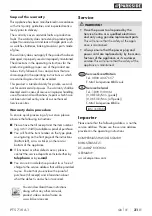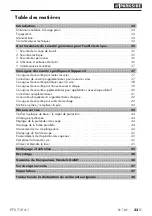
PTS 710 A1
■
22
│
GB
│
IE
Kickback is a result of saw misuse and/or incorrect
operating procedures or conditions. This can be
avoided by taking proper precautions as given
below.
a)
Hold the saw firmly in both hands and position
your arms such that they can absorb the force
of a kickback. Always stand to the side of
the saw blade and never in line with it.
If a
kickback occurs, the circular saw may jump
backwards. However, the operator can control
the kickback forces by taking appropriate pre-
cautions.
b)
If the saw blade jams or you stop working,
switch the saw off and hold it steadily in the
workpiece until the saw blade has completely
stopped turning. Never attempt to remove the
saw from the workpiece or pull it backwards
while the saw blade is still moving as this
could lead to a kickback.
Investigate and take
corrective actions to eliminate the cause of the
jam.
c)
If you want to restart a saw that is still in the
workpiece, centre the saw blade in the cut
and check to ensure that the teeth are not
caught anywhere in the workpiece.
If the saw
blade catches, it can jump out of the workpiece
or cause a kickback when the saw is restarted.
d)
Support large panels to minimise the risk of
the blade jamming and kickback.
Large panels
tend to bend under their own weight. Panels
must be supported on both sides, in the vicinity
of the saw cut and also at the edge.
e)
Do not use blunt or damaged saw blades.
Saw blades with blunt or misaligned teeth may
cause excessive friction if the saw cut is too
narrow, and this can cause a saw blade jam
and kickback.
f)
Before sawing, ensure that the fastenings for
the cut depth and cut angle settings are tight-
ened.
If the settings change while sawing, the
saw blade might jam and cause a kickback.
g)
Be particularly careful when sawing in ex-
isting walls or other obscured areas.
The
inserted saw blade could get caught on hidden
objects and cause a kickback.
Specific safety instructions for this
saw
Function of the lower blade guard:
a)
Before every use, check to ensure that the
blade guard closes properly. Do not use the
saw if the blade guard does not move freely
and does not close immediately. Never jam
or fasten the blade guard; this would leave
the saw blade unprotected.
If the saw is ac-
cidentally dropped, the blade guard may be
bent. Ensure that the blade guard moves freely
and does not touch the saw blade or other
parts at any cutting angles or depths.
b)
Check the condition and function of the
spring for the blade guard. Have the saw
serviced before using it if the blade guard
and spring are not working properly.
Dam-
aged parts, sticky deposits or accumulations of
chippings can cause the lower blade guard to
operate slowly.
c)
When making a "plunge cut" that is not at
right angles, secure the base plate of the
saw to prevent any lateral movement.
Lateral
movement can cause the saw blade to jam, thus
causing a kickback.
d)
Do not leave the saw on the work bench or
floor if the blade guard is not fully covering
the saw blade.
An unprotected, coasting saw
blade will move the saw in the opposite direc-
tion to the cutting direction and saw anything in
its path. Always, take into account that the saw
blade takes some time to stop spinning.
Summary of Contents for PTS 710 A1
Page 85: ...PTS 710 A1 82 PL...
















































